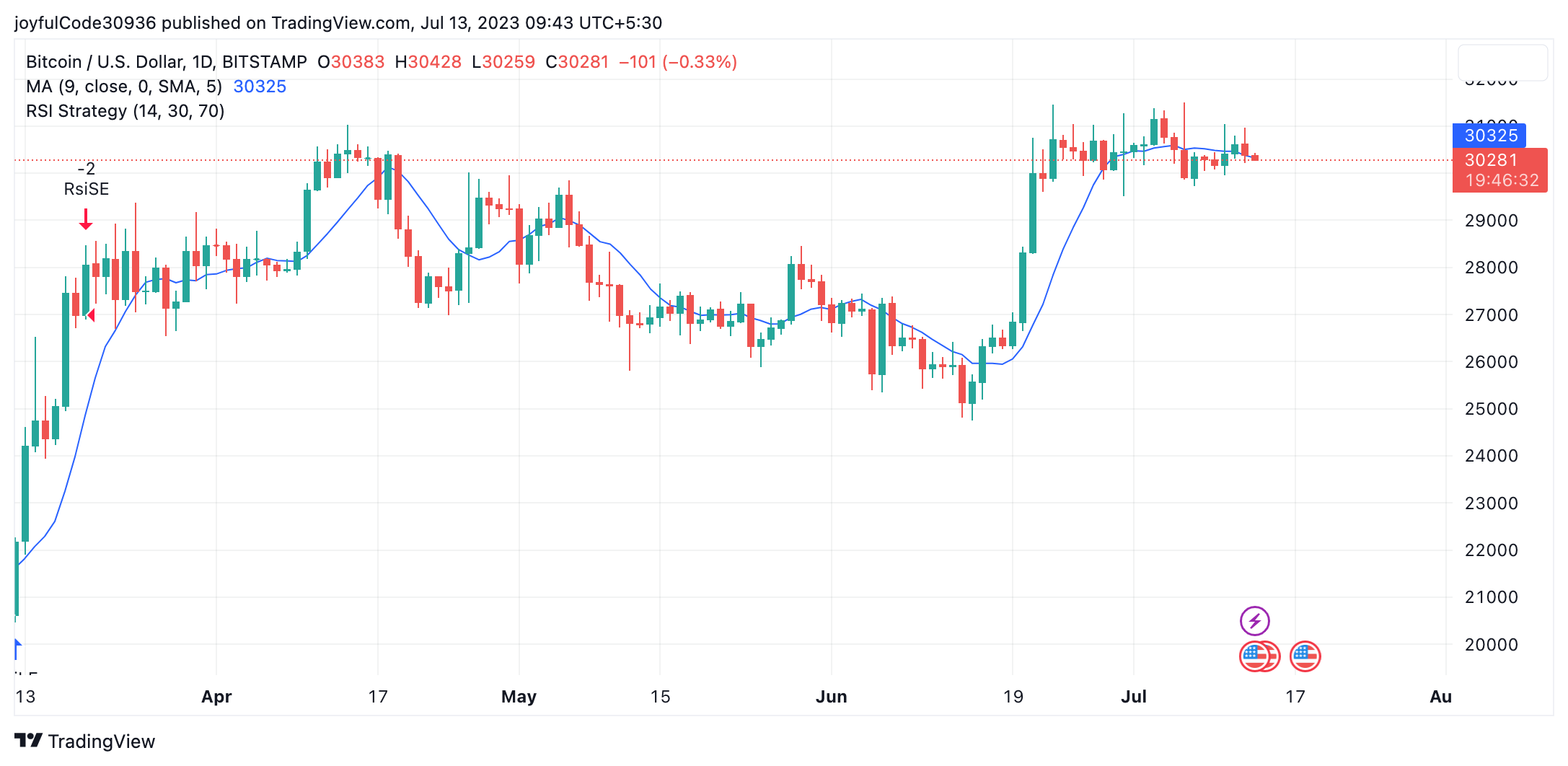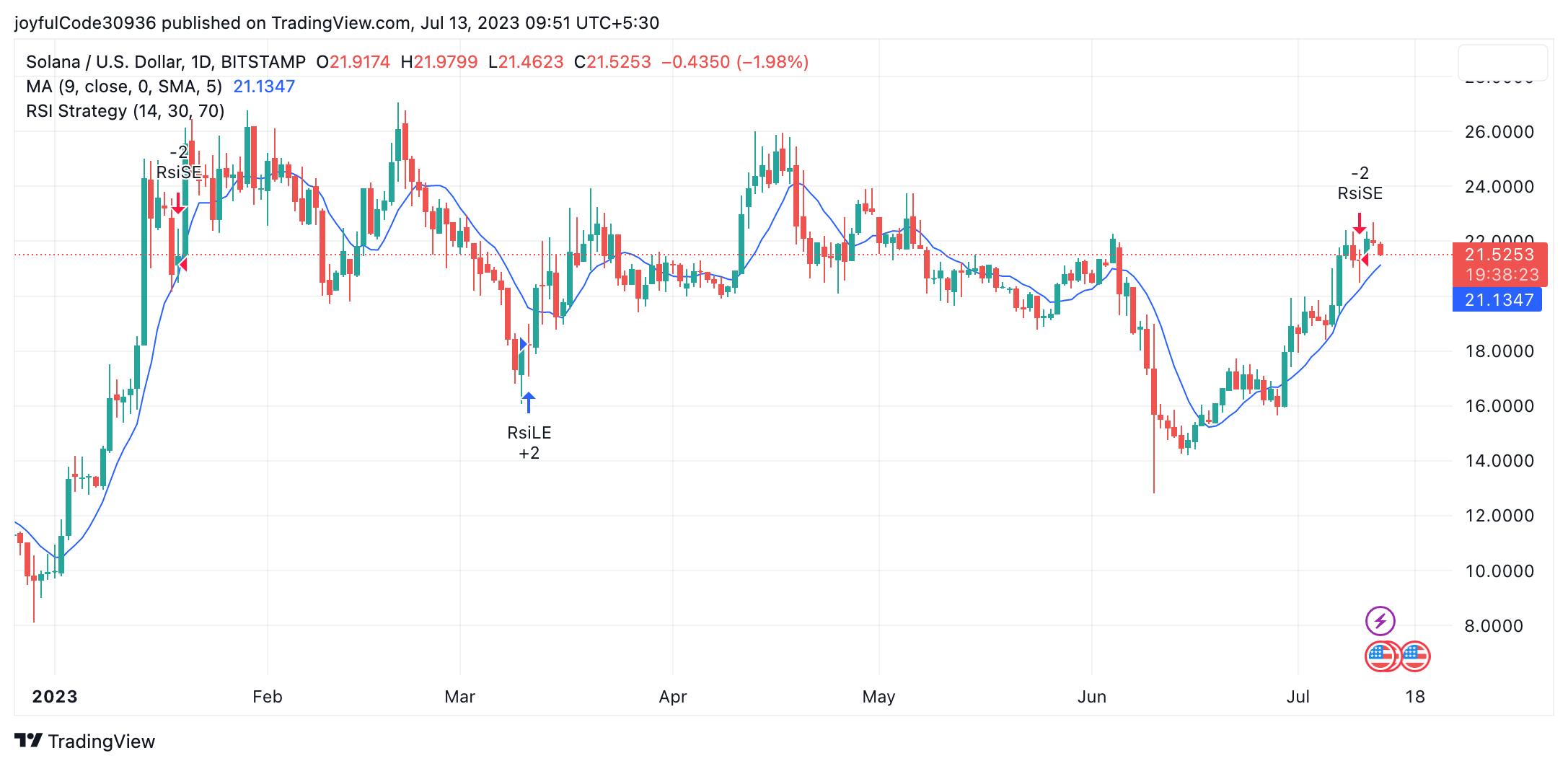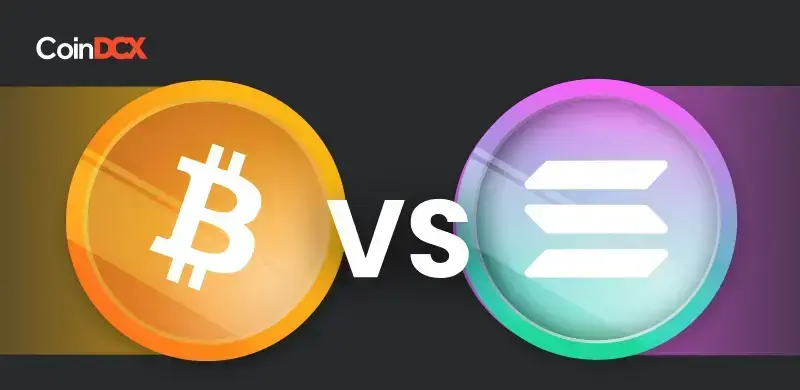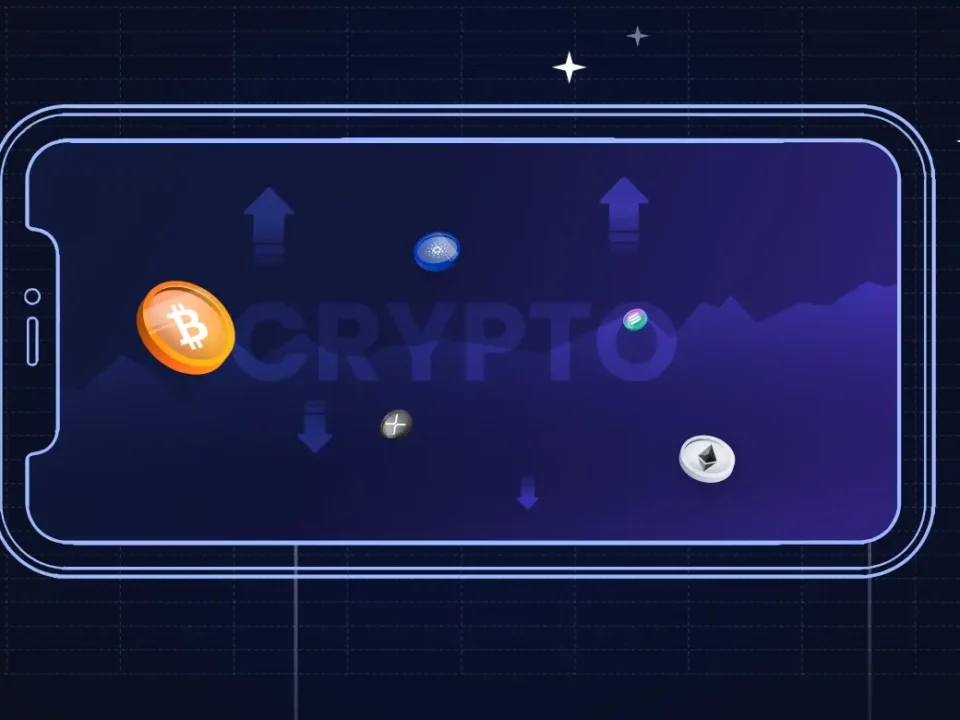Table of Contents
ToggleIntroduction:
In the rapidly evolving landscape of cryptos, Bitcoin and Solana have emerged as prominent players. Bitcoin, the pioneering digital currency, has enjoyed unrivaled popularity and market dominance for over a decade. On the other hand, Solana, a relatively new blockchain platform, has gained traction as a scalable and efficient alternative. In this blog post, we will delve into the unique features, strengths, and limitations of Bitcoin and Solana, comprehensively comparing these two leading crypto tokens.
Bitcoin: The Trailblazing Crypto
Bitcoin, introduced in 2009 by an anonymous person or group known as Satoshi Nakamoto, revolutionized the concept of decentralized digital currencies. It operates on a public blockchain, using a proof-of-work (PoW) consensus mechanism. Bitcoin’s main value proposition lies in its security, immutability, and scarcity. Its fixed supply of 21 million bitcoins makes it a deflationary asset, which is a key factor contributing to its store of value narrative. Moreover, Bitcoin’s first-mover advantage and wide acceptance have solidified its position as the poster child of crypto.
Key Features of Bitcoin (BTC):
- Decentralization: Bitcoin is not controlled by any central authority or government and operates on a decentralized network. Transactions are verified and recorded by a distributed network of nodes, ensuring no single entity has complete control over the currency.
- Security: Bitcoin’s security is maintained through its robust cryptographic algorithms. Transactions are secured by public-private key pairs, making it extremely difficult for hackers to manipulate or counterfeit transactions. Bitcoin’s underlying blockchain technology also ensures transparency and immutability of transaction records.
- Limited Supply: Bitcoin is capped at 21 million coins. This scarcity is built into its code and ensures that new Bitcoins are created at a diminishing rate over time. This limited supply contributes to its store of value narrative and protects against inflation.
- Pseudonymity: Bitcoin transactions are pseudonymous, meaning that while transactions are recorded on the public blockchain, the identities of the individuals involved are not directly linked to their real-world identities. Instead, users are identified by their unique wallet addresses, providing a level of privacy.
- Global Accessibility: Bitcoin can be accessed by anyone with an internet connection, irrespective of their geographical location. This global accessibility makes it an attractive option for individuals in regions with limited access to traditional financial services.
- Peer-to-Peer Transactions: Bitcoin allows for direct peer-to-peer transactions without the need for any third parties. This enables individuals to send and receive funds directly, reducing transaction costs and eliminating the need for third-party trust.
- Irreversible Transactions: Once a Bitcoin transaction is confirmed and recorded on the blockchain, it becomes virtually irreversible. This feature provides protection against fraudulent chargebacks and enhances the security of transactions.
- Transparency: Bitcoin’s blockchain is public, meaning that anyone can view and verify transactions. This transparency fosters trust and accountability within the network by allowing users to independently verify transaction histories.
- Portability: Bitcoin is digital and can be stored in a digital wallet, making it highly portable. This portability allows for easy transfer of funds across borders and eliminates the need for physical cash or traditional banking systems.
- Store of Value: Bitcoin has gained recognition as a store of value, similar to gold or other precious metals. Its scarcity, decentralized nature, and growing adoption by institutions have contributed to its perception as a hedge against inflation and a long-term investment asset.
How does Bitcoin work?
- Bitcoin operates on a decentralized network using blockchain technology.
- Users create transaction messages with recipient’s address, amount, and digital signature.
- Nodes validate transactions, verify signatures, check funds, and prevent double-spending.
- Miners compete to solve math puzzles, add validated transactions to blocks, and secure the network.
- Miners broadcast solutions, and nodes verify and accept correct blocks to establish an agreement.
- Validated blocks form a chronological chain, creating an immutable record of all transactions.
- Miners are rewarded with newly minted Bitcoins and transaction fees for securing the network.
- Users store Bitcoins with private keys for access and transaction generation in digital wallets.
Comparing Bitcoin vs Solana
| Parameter | Bitcoin | Solana |
| Launch Date | 2009 | 2020 |
| Founder | Satoshi Nakamoto | Anatoly Yakovenko and Greg Fitzgerald |
| Blockchain Protocol | Bitcoin | Solana Protocol |
| Native Token | BTC | SOL |
| Market Cap |
$594,634,671,129
|
$8,819,424,946
|
| Token Type | Native | Altcoin |
| Circulating Supply |
19,427,175 BTC
|
402,775,003 SOL |
| Max Supply | 21 million | – |
| Consensus Method | Proof of Work | Proof of History |
Solana: The Scalable Blockchain Platform
Solana, launched in 2017 by Anatoly Yakovenko, is designed to address the scalability and speed limitations experienced by several existing blockchains. Built upon a unique protocol called Proof-of-History (PoH), Solana aims to offer a high-performance decentralized platform for various applications. Its key features include a high throughput capacity, low transaction fees, and sub-second confirmation times. Solana’s focus on scalability positions it as a potential competitor to Ethereum and other smart contract platforms, offering developers an environment to build and deploy decentralized applications (dApps).
Key Features of Solana (SOL):
- Scalability: Solana is known for its exceptional scalability, capable of processing a high number of transactions per second (TPS). Its unique protocol, Proof-of-History (PoH), combined with other innovative consensus mechanisms, enables Solana to handle thousands of TPS, making it suitable for high-performance decentralized applications.
- Fast Confirmation Times: Solana achieves near-instant transaction confirmation times, typically in sub-second intervals. This quick confirmation enables seamless user experiences and makes Solana suitable for real-time applications such as decentralized finance (DeFi), gaming, and high-frequency trading.
- Low Transaction Fees: Solana’s efficient network design and scalability contribute to low transaction fees. This affordability makes it attractive for users and developers, especially when compared to other blockchain platforms that experience congestion and high fees during peak usage.
- Decentralization and Security: Solana maintains a strong emphasis on decentralization and security. Validators in the Solana network are distributed globally, ensuring a distributed consensus mechanism. This distributed network enhances security by making it more difficult for malicious actors to compromise the system.
- Developer-Friendly Environment: Solana provides a developer-friendly ecosystem that supports the creation of decentralized applications (dApps) and smart contracts. It offers compatibility with Ethereum’s Solidity language, enabling developers to port their existing Ethereum applications to Solana easily. The platform also provides extensive tooling, documentation, and resources to support developers in building and deploying dApps.
- Interoperability: Solana is designed to be interoperable with other blockchains, allowing for seamless communication and asset transfers between different blockchain networks. This feature opens up possibilities for cross-chain functionality and integration with other decentralized finance protocols and ecosystems.
- Tokenomics: Solana has its native crypto called SOL. SOL serves multiple purposes: transaction fees, staking rewards for validators, and governance participation. SOL holders can participate in the platform’s governance and decision-making processes.
- Community and Adoption: Solana has gained significant traction and community support due to its technological advancements and developer-friendly features. It has attracted various projects, including decentralized exchanges (DEXs), lending platforms, and NFT marketplaces, contributing to its growing ecosystem and adoption.
- Ecosystem Expansion: Solana actively focuses on expanding its ecosystem through partnerships, grants, and incubator programs. These initiatives encourage innovation, support developers, and drive the growth of the Solana ecosystem by fostering the creation of new applications and services.
- Future Development: Solana’s development roadmap includes ongoing improvements, such as advancements in privacy, further scalability enhancements, and layer-two solutions. The Solana team aims to continue pushing the boundaries of blockchain technology and addressing the evolving needs of the ecosystem.
How does Solana work?
- Proof-of-History (PoH): Solana’s PoH protocol establishes a common understanding of time among nodes, enabling efficient transaction processing.
- Replication and Consensus: Validators in the network validate transactions using a PoS consensus mechanism and propose/vote on blocks based on their stake.
- Tower BFT Consensus: Solana uses Tower BFT, a variant of PBFT, for fast finality and secure block validation.
- Sharding: Solana employs sharding to process transactions in parallel across independent shards, enhancing scalability.
- Transactions and Smart Contracts: Users submit transactions, including SOL transfers and interactions with smart contracts written in Rust or Solidity.
- Replication and Data Storage: Gulf Stream optimizes network bandwidth by replicating data, ensuring all nodes have the latest blockchain state.
- Tokenomics and Incentives: SOL is Solana’s native crypto used for transaction fees, staking rewards, and participation in governance.
- Ecosystem and Interoperability: Solana supports developers with tools, grants and fosters an ecosystem while enabling interoperability with other blockchains.
Key Differences between BTC vs SOL:
- Scalability: Bitcoin has limited scalability, processing around 7 transactions per second (TPS), whereas Solana has achieved remarkable scalability, capable of handling thousands of TPS.
- Transaction Speed and Cost: With fluctuating fees, Bitcoin’s transaction confirmation times can vary widely, sometimes taking minutes to hours. Solana, on the other hand, offers near-instant transaction confirmations in sub-seconds with consistently low transaction fees.
- Consensus Mechanism: Bitcoin uses a proof-of-work (PoW) consensus mechanism, requiring substantial computational power and energy consumption. Solana utilizes a combination of proof-of-history (PoH) and proof-of-stake (PoS) consensus mechanisms, enabling faster confirmations and energy efficiency.
- Programmability and Smart Contracts: Bitcoin’s scripting capabilities are relatively limited, primarily focused on peer-to-peer transactions. On the other hand, Solana supports smart contracts and provides a platform for developers to build and deploy decentralized applications (dApps) using multiple programming languages.
- Development Ecosystem: Bitcoin’s ecosystem mainly revolves around Bitcoin itself, with a limited focus on dApp development. Solana strongly emphasizes supporting developers and fostering a vibrant ecosystem, offering tools, grants, and compatibility with Ethereum’s Solidity language.
- Market Maturity and Adoption: Bitcoin is the first and most well-known crypto, enjoying widespread adoption and recognition. Although rapidly growing, Solana is a newer blockchain platform and is still establishing its position in the market.
- Tokenomics: Bitcoin has a fixed supply of 21 million coins, contributing to its store of value narrative. Solana’s native crypto, SOL, has a different tokenomics model and is used for transaction fees, staking rewards, and participation in governance.
- Focus and Use Cases: Bitcoin primarily serves as a decentralized digital currency and store of value. Solana aims to be a high-performance blockchain platform supporting various use cases, including decentralized finance (DeFi), gaming, and other dApp development.
Bitcoin Price Prediction

Source: TradingView
- BTC’s price has been going strong and staying within the $30,000 level since the beginning of July but is showcasing a possibility of undergoing a bearish pullback.
- Events like CPI rates, the GDP report, the ECB meeting, and, most importantly, the FOMC meeting to discuss further rates might push the bearish pull, and the price of BTC may dip to $29,000 levels.
- By the end of the month, the BTC price may trade between $29,500 to $30,500 after facing rejection from $31,200.
Read More: Bitcoin Price Prediction
Solana Price Prediction

Source: TradingView
- SOL’s price has remained bullish since July and is showing bullish behavior for the upcoming week as well.
- After trading sideways ever since it marked the yearly highs above $26, SOL’s price is currently standing at $21.50, which can go both ways in the upcoming week of July.
- If the price breaks through the resistance level of $20, there is a possibility of a rebound that may lift the price but may remain under consolidation around $22 level until the end of the month.
Read On: Solana Price Prediction
How to buy BTC & SOL
Investing in Bitcoin BTC or SOL is extremely simple, fast, and secure with the CoinDCX App. All you need to do is register on the platform. To register, follow the below-mentioned steps:
- Download CoinDCX App
- Register by entering your details.
- Complete KYC and verify your mobile and email.
- Once your profile is validated, add funds to your wallet
- Buy BTC or SOL.
Related posts
Understanding the Different Types of Cryptos: Coins, Tokens, Altcoins & More Explained
Explore the major types of crypto assets and their unique roles.
Read more
PAWS Telegram Game: The New Tap to Earn Game That Is Beating Hamster Kombat
Discover how to play and earn with PAWS Telegram game.
Read more


